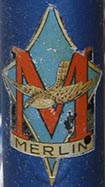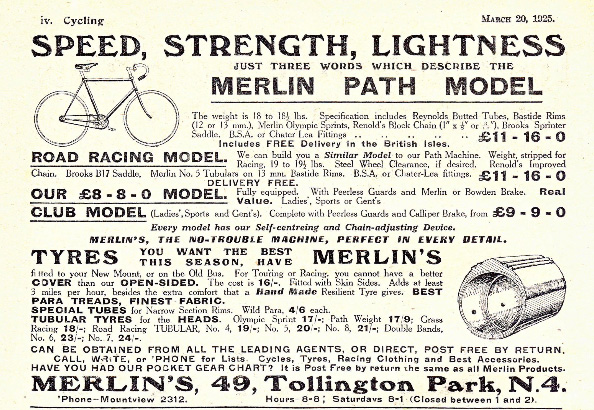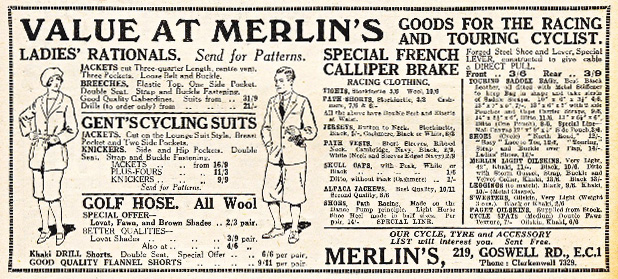Merlin Cycles- Their beginnings and early years
Posted: Monday 08th June 2020
The 14th of March 1850 saw a steel grey sky trap the smoke and dockyard smells of Victorian London. A young fifteen year old lad called Paolo followed the older man down the gangplank from the Dutch ship Batavia on which they had crossed from Rotterdam. His surname was Merlini and he had come a long journey from his native Milan. The older man was a sculptor and signed the aliens register with a flourish but Paolo struggled; his education had mostly been with a chisel in his hand. Nevertheless, and just before his own death, two grandsons, Ernest and Augustus, would start a small tyre and bicycle business in the heart of London that would survive until they both retired in the middle of the next century.

The progress from sculptor’s apprentice to cycle makers is of interest; Paolo swapped stone for wood and carved that instead, becoming a clock and barometer case maker and by 1871 employed two men and an apprentice of his own. He had married a girl called Lavinia from Bethnal Green and together they had six children in their house at 3 Torrington Street, Clerkenwell – four of them born in Italy (so Paolo had made enough money to travel back and forth with the family). His two sons Felice (Felix) and Vincenzo (Vincent) both joined their father as wood carvers.
On 11th October 1884 Felix married (like his father) an English girl from Liverpool Street in the City. Ella Francis Tucker was the daughter of a compositor, and within a year they had their first son Augustus Leonard Merlini, born on 4th August 1885 at the family home, 13 Skinner Street, Clerkenwell. His birth was followed a year later by that of his brother Ernest Alfred Merlini born at 45 Seckforde Street as the couple had moved. They moved again to Chadwell Street as the boys grew and the business prospered – by 1891 Felix and Ella could afford to employ a servant girl, Rose Turner from Peckham.
A further move to Woodbridge Street, Clerkenwell saw Augustus (Gus) aged 15 in his first job, as a clerk in the County Council offices. Felix had now applied for and been granted British citizenship. Six years later, in 1907, Grandpa Paolo died aged 72, his family by now well established and soon to drop the “i” from the end of their surname. In the 1911 census Felix now called himself Frank Merlin with Gus still at his side as a wood carver. Ernest however had branched out and had become an electrical engineer. Furthermore he was now a keen and fairly successful cyclist, having joined the Polytechnic CC in 1905.
The Olympics in 1912 were held in Stockholm and the road cycling event was a long (by today’s standards) individual time trial of 196 miles (just over 315 kms). The British sent no less than twenty-six riders forming individual teams from England, Scotland and Ireland (there were only 123 in the entire event representing sixteen countries). Ernest had been selected and finished in the middle of the field at 59th place with a time of 12 hours 16 minutes and 8.6 seconds.
The winner was a South African, Rudolph Lewis, but the star from the English point of view was one Frederick Henry Grubb, winner not only of the individual silver medal but leader of the team of four Englishmen who also won silver for the team time trial (first four to count, the others being Leon Meredith, Charles Moss and William Hammond). Despite finishing over an hour behind the medalists Ernest does not seem to have been downhearted and his career flourished with fastest times in the Anfield 100, Kingsdale 50, Gayley 12 hour and, with H. Fowler, holder of the Lands End to London tandem record from 1923 to 1926 (they were the first to take the record below twenty hours with a time of nineteen hours and thirty-seven minutes).
All too soon the Great War broke out and immediately Gus joined up, initially in the London Regiment. On the 4th November 1914 he sailed for France thus earning himself the 1914 (Mons) Star. Amazingly he survived the entire conflict, transferring to the Machine Gun Corps in 1916. Brother Ernest was also in the MGC and may have been the reason for the transfer. Gus still called himself Merlini when he joined up but Ernest had, by now, dropped the “i”. With the coming of peace it seems that the brothers put their past trades behind them and started the business that they called The Merlin Tyre Company.
By 1923 the company was trading as Merlin’s from its initial premises at 49 Tollington Park, London, N4 and was selling tyres, their own brand of lightweight cycles and clothing too. They had taken as their motto Merlin Lightweights – the No-Trouble Cycles. They remained at Tollington Park until 1928 but by September of that year had moved to their final shop at 219 Goswell Road, Clerkenwell.
For further and later information about the Merlins refer to Bill Ives piece on this site together with the 1940 catalogue therein. Some early Merlin advertisements from copies of Cycling in the 1920s follow. The writer is currently restoring a pre-war Merlin frame and would welcome information regarding transfers other than that which heads Bill Ives article.
Posted: Monday 08th June 2020
Chapters
This article appears in the following categories.
Upcoming Events
Whether you are looking for a gentle social meet up, or a 100-mile ride browse the community’s upcoming events and plan your next weekend outing.




